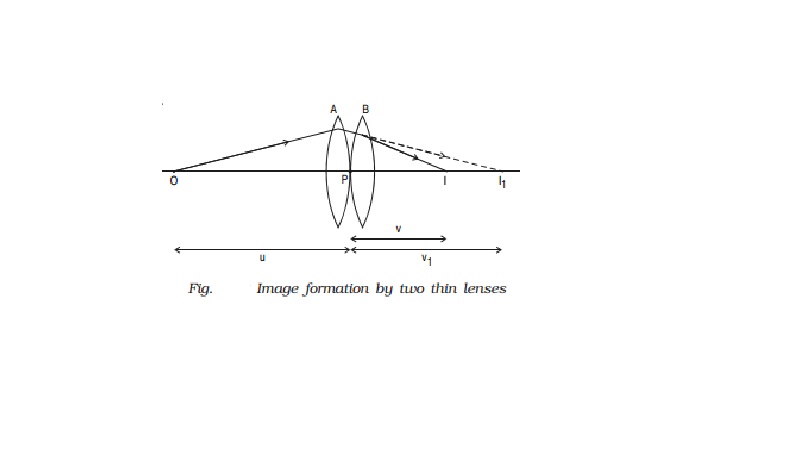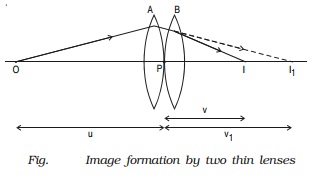Chapter: 11th 12th std standard Class Physics sciense Higher secondary school College Notes
Combination of thin lenses in contact

Power of a lens
Power of a lens is a
measure of the degree of convergence or divergence of light falling on it. The power of a lens (P) is defined as the
reciprocal of its focal length.
P=1/f
The unit of power is
dioptre (D) : 1 D = 1 m-1. The power of the lens is said to be 1 dioptre if the focal length of the lens is 1
metre. P is positive for
converging lens and negative for diverging lens. Thus, when an optician
prescribes a corrective lens of power + 0.5 D, the required lens is a convex
lens of focal length + 2 m. A power of -2.0 D means a concave lens of focal
length -0.5 m.
Combination of thin
lenses in contact
Let us consider two
lenses A and B of focal length f1 and f2 placed in contact with each other. An object
is placed at O beyond the focus of the first lens A on the common principal
axis.
The lens A produces an
image at I1 . This image I1 acts as the object for the
second lens B. The final image is produced at I as shown in Fig. Since the lenses are thin, a common optical
centre P is chosen.

Let PO = u, object distance for the first
lens (A), PI = v, final image
distance and PI1 = v1, image distance for the
first lens (A) and also object distance for second lens (B).
For the image I1 produced by the first lens A,
1/v1 ? 1/u
= 1/f1 ????..(1)
For the final image I,
produced by the second lens B,
1/v - 1/v1 = 1/f2 ????..(2)
Adding equations (1)
and (2),
1/v ? 1/u = 1/f1
+ 1/f2 ????..(3)
If the combination is
replaced by a single lens of focal length F such that it forms the image of O
at the same position I, then
1/v - 1/u
= 1/F ????(4)
From equations (3) and
(4)
1/F = 1/f1 +
1/f2 ?????(5)
This F is the focal
length of the equivalent lens for the combination. The derivation can be
extended for several thin lenses of focal
lengths f1,
f2, f3 ... in
contact. The effective focal length of the combination is given by
1/F = 1/f1 + 1/f2 + 1/f3 + ?????.. ?..(6)
In terms of power,
equation (6) can be written as
P = P1 + P2 + P3 + .... ...(7)
Equation (7) may be
stated as follows :
The power of a
combination of lenses in contact is the algebraic sum of the powers of
individual lenses.
The combination of
lenses is generally used in the design of objectives of microscopes, cameras,
telescopes and other optical instruments.
Related Topics